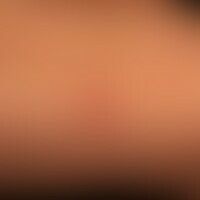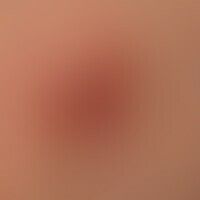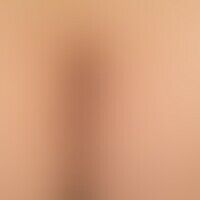Dermatitis herpetiformis Images
Go to article Dermatitis herpetiformis
Dermatitis herpetiformis: chronically recurrent course of the disease. persists for about 3 years. disseminated, burning, partly also stinging urticarial papules, papulo vesicles and erosions.







Dermatitis herpetiformis. disseminated, mostly eroded papules (vesicles not detectable here!) on the elbow and the extensor side of the forearm. recurrent course for months with tormenting, prickly itching.


Dermatitis herpetiformis. grouped, urticarial papules with erosions and crusts of 2-4 mm in size on light to deep red erythema. in the centre smaller polygonal vesicles. the colourful juxtaposition of different efflorescences is characteristic of dermatitis herpetiformis.

Dermatitis herpetiformis. 3 months recurrent, disseminated, papules and vesicles on distinct erythema in a 59-year-old patient. in several efflorescences a blown off halo (bright rim) is visible. at the right border of the picture several fresh, barely 1 mm large reddened papules. the symptoms are described as unpleasantly stinging. no gastrointestinal symptoms.

Dermatitis herpetiformis. multiple, disseminated standing, itchy, scratched excoriations on the right arm of a 15-year-old patient. the scratched excoriations are located at sites where grouped vesicles had appeared a few days before. overall, the disease has existed for several months and shows a chronically recurrent course.

Dermatitis herpetiformis: multiple, disseminated, eminently chronic, itchy, prickly, scratched excoriations, few vesicles (note: the vesicles must be sought in DhD).


Dermatitis herpetiformis: blisters and bizarrely aggregated blisters on the extensor side of the upper arm. recurrent course for months with excruciating, piercing itching. in contrast to the pale skin, the diagnostically indicative, perilesional erythema is missing.

dermatitis herpetiformis: chronic recurrent course of the disease. disseminated, burning, itchy, urticarial papules, papulo-vesicles and erosions. lesions are aggregated to larger plaques. p. detail images.



Dermatitis herpetiformis: chronically recurrent course of the disease. disseminated, burning, itchy, urticarial papules, papulo-vesicles and erosions. lesions are aggregated to larger plaques (here circled). p. detail images.



Dermatitis herpetiformis: chronically recurrent course of the disease; detailed picture of a urticarial plaque

Dermatitis herpetiformis. detailed view of several, chronically active, disseminated papules, red spots and vesicles localized at the integument and accompanied by severe pruritus. characteristic is the occurrence of different types of efflorescence. similar skin lesions are also found gluteal and on both thighs.

Dermatitis herpetiformis: Multiple, prickly, itchy, scratched excoriations on the buttocks of a 35-year-old female patient. 1 year of intermittent progression.

dermatitis herpetiformis. multiple, itchy, scratched excoriations on the buttocks of a 15-year-old patient. the scratched excoriations replaced grouped blisters that had appeared a few days earlier. overall, the disease has existed for several months and shows a chronically recurrent course.


Dermatitis herpetiformis: Multiple, prickly, itchy, scratched excoriations in a 35-year-old female patient; the disease has existed for about 1 year with intermittent course.


Dermatitis herpetiformis. urticarial stage: slight irregular acanthosis, orthokeratosis. in the upper and middle dermis a partly diffuse, partly perivascularly compressed infiltrate of lymphocytes as well as neutrophil and eosinophilic granulocytes is visible; focal epidermotropy. several subepithelial fissures. in places neutrophil and eosinophilic granulocytes condense in the tips of the papillae (indicated intrapapillary microabscesses)

Dermatitis herpetiformis, orthokeratosis. In the upper and middle dermis, a partly diffuse, partly perivascularly compressed infiltrate of lymphocytes as well as neutrophil and eosinophilic granulocytes is visible; focal epidermotropy. In the centre of the preparation, neutrophil and eosinophilic granulocytes condense in the papilla tips to form intrapapillary microabscesses (clinically this will be recognizable as vesicles). In the outer papilla, right thinning of neutrophil granulocytes to form an intimate neutrophil abscess (clinically urticarial marginal reaction).


